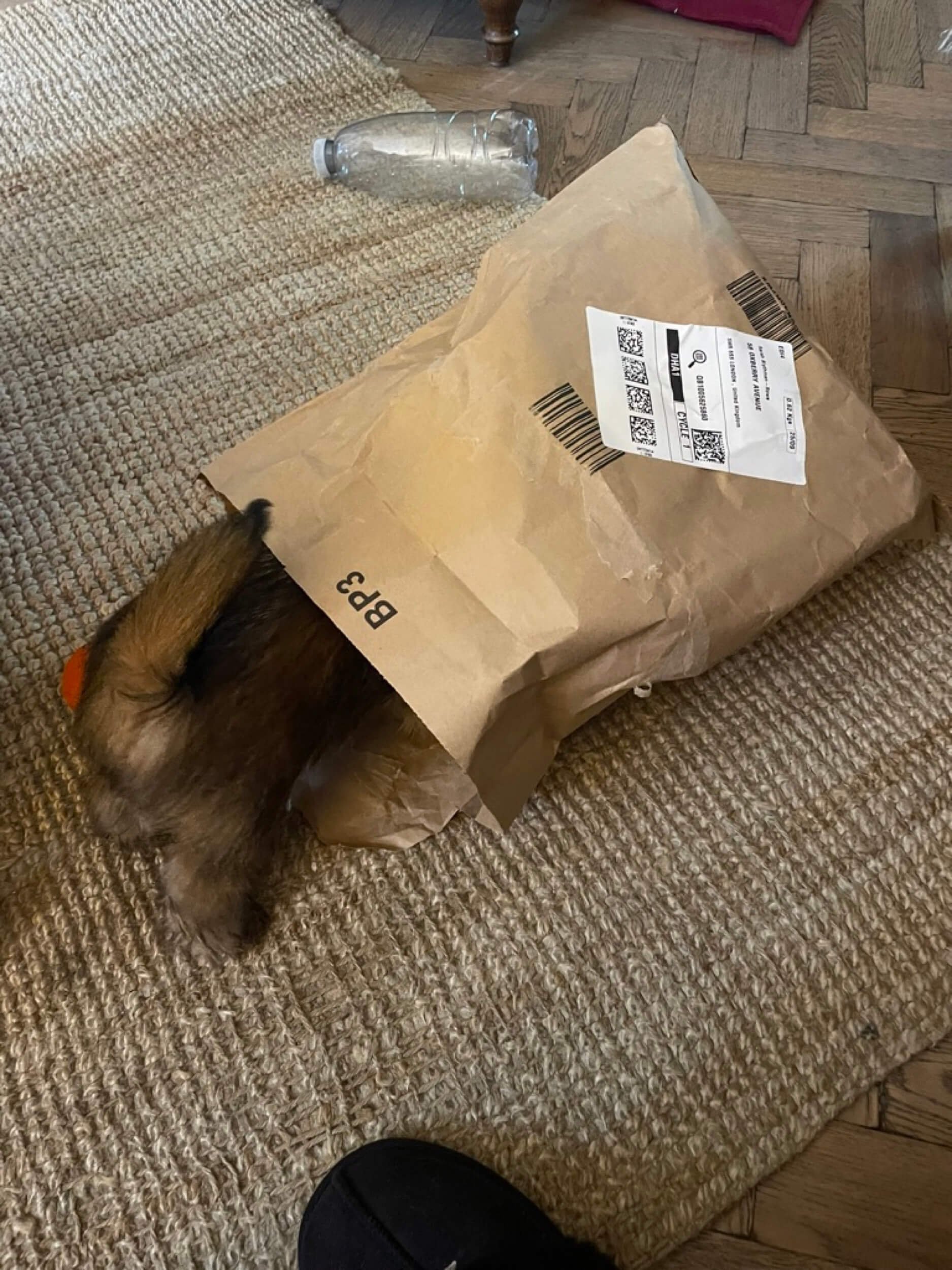9 puppy lessons I didn’t see coming - even after years of experience!
Sarah Blythman, founder of Reg&Bob, takes a no-nonsense approach to dog ownership
First meet
Friends…….
As many of you know since losing one of our founders - Reg in 2024, we’ve welcomed another Norfolk Terrier into the fold. Jim joined us at the end of last year and he’s been a big, excitable, super energetic bundle of joy.
It’s been a juggle with Bob who was so visibly sad when Reg left us only to find a bouncing overly enthusiastic puppy around instead. He has some mobility issues of his own so the combination has been challenging but when they’re cuddled up in bed together — I know it’s been worth it.
Jim is my fourth puppy so you’d think I’d know it all by now. But I didn’t feel I did and wanted to re-assess some of the ways I’ve done things.
I would also preface this by saying we’ve had a large number of health issues with Reg and Bob - I’m not sure these could have been avoided but they’ve been exceptionally distressing never the less (see previous blogs) and I want to do everything to support Jim with the healthiest lifestyle possible.
Puppy life stress
Since having Reg and Bob I’ve started my accessory business Reg&Bob - for dogs that want to be dogs. This has pushed me into the doggy world and given me access to a huge range of dog enthusiasts and experts. With that access and with the determination to find out as much as I can about a dogs physiology and characteristics, has given me really useful insights.
I would say these are my personal choices - many of the ways you develop with your dog are personal - one size doesn’t fit all and I am categorically not saying this is what everyone else should do. What I would say is do find out more - I have listed some great reading sources below.
And if you want to see how my approach has changed - take a look at the image at the end because there are certain things I said I’d never do - and now look what’s happened!!
DIY enrichment
Exercise: When it comes to exercising your puppy the daily directive of 5 mins per month of age is no longer the only rule we should follow. Galen Myotherapist Lucy Tyrrell says it’s much more about what type of exercise your puppy is doing. You should be limiting high impact activity such was running, jumping and twisting.
With Jim I’ve been keeping exercise sessions short - allowing him lots of rest and homemade enrichment. And to further protect and avoid additional stress on his joints - keeping slippery floors covered.
Our choice is raw - delicious!
Feed the Best You Can Afford I’ve had endless conversations about what to feed my dogs. With Reg and Bob, I tried a huge variety of options – all of which they happily devoured. Let’s face it, they’ve never been picky eaters; a decomposing pavement snack was as appealing to them as anything from a bowl.
When Jim arrived, he was on a raw food diet, and I decided to stick with it – even moving Bob onto the same. It’s a little more hassle since it arrives frozen and my freezer isn’t exactly spacious, but overall, it’s straightforward to feed and feels like the right choice. For those inevitable moments when I run out, I keep a freeze-dried alternative on hand. It’s convenient, and I can swap in a meal or two without the need for a slow transition.
I also like to add some extras: an egg each week, tinned mackerel or sardines for the omega-3s (in spring water) and even the odd handful of blueberries or a splash of kefir for a boost of nutrients.
The dog food world is a minefield, dominated by a few very big players. My advice is do your research and find something that works for you, your dog, and your budget. And if you can, include a few healthy extras to keep things interesting and nutritious. My go to guru on feeding is Jane Higgins from Woofs a Daisy who as a qualified canine nutritionist is always willing to advise on feeding.
Maintaining the dew claw. Historically breeders remove the dew claw soon after birth. The belief being it gets in the way - gets caught in things and causes injuries. But the dew claw is in the same anatomical position as our thumb and a dog will use the dew claw in the same way as their other claws (in certain gaits) and it’s used to grip and maintain traction and balance. In fact when a dog’s front paws come in contact with the ground when running at speed - the dew claw does too - allowing it to support natural functional movement.
This was new for me. Jim’s breeder didn’t remove it and since my research, I’m happy that we’ve still kept it and for all the right reasons.
Delay castration until a year to 18 months - depending on the size of your dog. In the past we’ve castrated our dogs at 6 months at the vet’s advice. But chatting with Lucy from Pawsitive Touch it’s better to leave castration a little bit longer to ensure the bones have stopped growing and growth plates have met - and this will vary according to the size of your dog.
Keep on training I’ll admit it – training has never been my strong suit. Of course I covered the basics, and things mostly worked out fine… or have I just forgotten? One of Reg’s most frustrating habits was running off with other dogs’ balls, which were impossible to get back – a direct result of not progressing beyond the basics!
Train, train and then do it again
And food has also been an issue. London living means discarded scraps and rubbish are everywhere, and that constant search for food has sometimes led to worrying behaviour.
With Jim, I’ve decided to take a more committed approach to training. It’s not just about having a well-behaved dog (though that’s a big plus); training is also fantastic for dogs’ mental stimulation. They love to please, and teaching tasks and tricks keeps their brains engaged and happy.
Every week, Jim and I head to Pet Necessities training classes – held outside, where learning feels more natural. Progress isn’t instant, but it’s happening. I’m not aiming for perfection or expecting Jim to become the best-trained dog in the park, but it’s an ongoing process that takes effort from both of us and I’m certainly putting in more time than ever before. Ultimately I want us to have the skills to stay safe and provide ongoing enrichment for Jim.
Early socialisation Having a new puppy while Bob has been recovering from an injury has meant our social life has taken a back seat. So instead of being out and about we’ve entertained at home and that’s meant friends bringing their dogs.
I really think that early socialisation has made such a difference to Jim’s confidence. He’s definitely an extrovert but that hasn’t meant he’s confident in every situation - in fact he’s terrified of the local hamburger van in the park - which was always a magnet for Reg and Bob!
Social Jim
A gently introduction to friends dogs especially on his own turf has made all the difference and built up his confidence early on. Things may change with his confidence as he progresses into adolescence - so it’s important I’m ready to adapt how I do things and if necessary consult with my trainer for advice.
Be warned the park experts. I’ve stood at the school gate and I learnt to take all the uncalled for advice with a pinch of salt. The park is also full of “experts” eager to dish out advice – whether you’ve asked for it or not.
Now who’s right……..
While most mean well, it’s best to leave the guidance to the professionals who truly know their stuff. Even now, my husband will come back from a walk convinced some random dog owner’s advice trumps our vet’s!
Listen politely, if you like, but when it comes to your dog’s health or behaviour, stick to advice from qualified professionals. It’ll save you a lot of confusion – and possibly a few heated debates!
I’m a harness convert
Jim’s first harness - Reg&Bob obviously
Reg and Bob didn’t grow up wearing harnesses – I’ll admit, I wasn’t a fan. That changed when I met Galen Myotherapist Lucy Tyrrell, who designed the Reg&Bob harness. She opened my eyes to the benefits of a well thought out design.
What put me off before? So many harnesses looked ridiculous! But Lucy explained the key benefits: a properly designed harness prevents pressure on the dog’s neck while walking on a lead. It also avoids restricting movement by keeping muscles and joints free from unnecessary clips and fabric.
Never say never - I’m now using a buggy!
Too many harnesses are over-engineered - putting fashion before function. Reg&Bob’s harness with it’s simple design – in our bespoke vibrant stripes – gets it just right. Jim looks fantastic in his and it’s so comfortable he would probably sleep in it if I let him!
Every dog is different Jim’s our fourth Norfolk Terrier, and you’d think by now I’d have it all figured out. But no – Ted, Reg, Bob, and Jim have been completely different in character. Each one has bundles of personality, but their temperaments couldn’t be more varied.
Ted was cautious and thoughtful, Reg had a stubborn streak but loved to please. Bob was the comedian, always keeping us amused. And Jim? He’s got his own quirks which I’m still discovering.
This is the beauty (and challenge) of dogs: no two are the same. That’s why it’s so important to watch how your dog reacts to new situations, notice what makes his tail wag, and be open to the personality he’s growing into.
My dogs aren’t carbon copies of each other – and that’s what makes them so special.
So that’s my top 9 changes to my thinking since Jim’s arrival. What do you think? Have you had different experiences with your puppies? Let me know in the comments below.
Don’t take my word for it - read from the real experts……
Sources
Pet Necessities Training & Behaviour, Egham, Surrey
Lucy Tyrrell, Pawsitive Touch, Surbiton, Surrey
How to build a Puppy by Julia Robertson
Everything your puppy wants you to know by Louise Glazebrook
Jane Higgens Woofs a Daisy, Kingston upon Thames KT2 7AG











